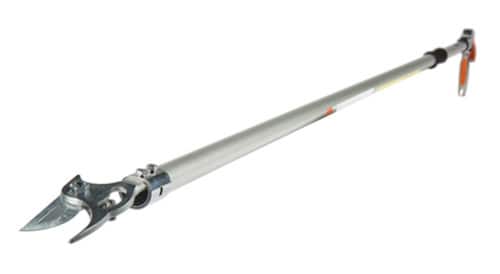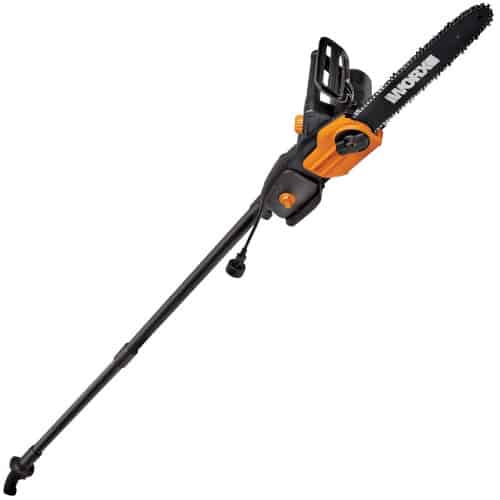Are you a perfectionist who likes seeing perfectly trimmed trees in their backyard? If yes, then you have come across the perfect read! Generally, people climb a ladder or a stool holding a saw to reach the height of a tall branch that needs to be cut, putting their safety at risk. Pruning shears and pole saws are made to eliminate the need for dangerous climbing.
While both pole saws and pole pruning shears are used to trim or prune larger trees with the help of telescopic poles, either of these garden tools have their own very distinct uses and advantages. Pole saws are either manual, electric or gas powered and these are used mainly for the rough cutting of large branches that are too large and too high for regular chainsawing.
Meanwhile pole pruning shears are for the delicate pruning and trimming of trees with a large canopy. In short, pole saws are for the heavy work, while pole pruning shears are for the meticulous pruning of the otherwise unaccessible, selected branches.
A pole saw is an electrical tool, while a pruning shear is a manual one. Let us discuss each tool in detail so you can decide what is better for you!
Trimming or Pruning
Pruning and trimming are two terms used interchangeably but are different. Pruning removes dead, loose, or infected branches or stems from their respective plant while trimming cuts back overgrown plants.
Uses of Pole Shears
Pole shears serve different functions. They make your garden not only an aesthetic space but a safe space for you and your loved ones as well. Pole shears are used for various purposes, some of which are elaborated below:
Trimming Minor Branches of the Tree Crown
Big trees sometimes have an overgrowth around them consisting of tiny plants. These look untidy and affect the aesthetic of your garden. Pole shears are used to cut down this minor overgrowth. It may sound like a convenient option, but in reality, it is quite troublesome. Many professionals still use the conventional methods of using a ladder and a saw or other tools to eliminate this overgrowth.

Pruning Water Sprouts
The peculiar and out-of-character growth can quickly identify water sprouts or epicormic shoots emerging from the trunk or the associated limbs of a tree. These growths are termed suckers because they provide no benefits, such as bearing fruits or flowers, even though they utilize the resources provided to a tree. To increase liability, they even grow at a very fast rate. You are probably used to these if you have ever grown honey locusts or apple trees. Pole shears are used to cut these thin shoots growing out of the trunk or branches easily to ensure your tree’s more productive growth.
Pruning Vines
Vines are long stems that grow along with the support or creep over the ground. You can employ pole shears to cut part of these vines or all of it, as required, from a tree to neaten its look.
Trimming Climbers and Wall Shrubs
Climbers are plants that seek support from other plants or structures to continue their upright growth. Common climbers are clematis, trumpet creepers, and some roses. Prune shears can trim and tidy these up as well.
Uses of Pole Saws
Pole saws serve different purposes than pole shears. Some common uses are discussed below to help you decide if this is the tool that your garden needs:
Cutting Large Branches
The best use of a pole saw is in cutting large branches that are unreachable otherwise. Climbing a ladder with a saw in your hand is tedious and unsafe and can lead to many accidents. With a pole saw at hand, you can easily just stand on the ground and reach any large branches you see. Nowadays, many professionals use pole saws to clear high branches and shape the trees. A pole saw’s ability to reach distant and thick branches is what pruning shears generally lack.
Trimming Large (or Thorny) Bushes
Pole saws can eliminate the need for bush trimmers by facilitating the trimming of large or thorny bushes. Bushes are cut in the same manner as the branches of a tree. They have a messy growth, which makes it difficult to locate the thorns. They may also have harmful insects or snakes and may even be a fire hazard in some situations. It is better to use a pole saw to clear out the bush’s undergrowth or ground cover for construction purposes or fire control safety.
Removal of Dead Branches
Pole saws can be used to remove the dry branches of a tree that otherwise hinder productive growth. When numerous unwanted branches emerge from a tree, they consume resources without benefiting the tree. Moreover, these branches may block sunlight for other plants in the garden as well. A pole saw is usually used to eliminate this problem by cutting off these dead, obstructed, or dying branches for safety purposes or as a necessity.

Types of Pole Shears
All pole shears are not necessarily the same. They are different in their build and mechanism and hence serve different purposes. The types of pole shears and their purposes are listed below:
- Bypass Pruners: These are the most common type of pole shears. They are built like scissors and function similarly as well. Out of the two blades, one is curved, and the other is sharp. For the best results, the bypass pruner needs to be sharpened regularly. The branch goes between the two blades, giving a clean and neat cut.
- Anvil Pruners: Unlike bypass pruners, anvil pruners have one sharp blade lowered and pressed against the flat anvil to cut the desired branch. They are useful in cutting thick branches. Anvil pruners are effective even when blunt because both sides of the blade on the pruner are sharp.
- Ratchet Pruners: These have a special mechanism that helps cut tough and strong branches even if you are someone with poor hand strength. When the handle is squeezed inwards, the cutting blade moves down and latches into its place. You can then release the handle and squeeze it again, pushing the blades farther together. This way, you can gradually make progress rather than having to press the blades in one go. Ratchet pruners are ideal for people with muscular issues or arthritis.
Types of Pole Saws
Similar to pole shears, pole saws are designed to accomplish different tasks. They differ in their shapes and unique curvature. The commonly found pole saws are:
- Gasoline-powered Pole Saw: This is mostly used for heavy-duty work done by professionals. It can reach a minimum height of six feet and a maximum of ten to twelve feet and is very easy to use. A downside of this pole saw is the noise it produces. People who use gasoline-powered pole saws use noise cancellation earphones alongside. However, they are great for professional use because they run for a long time on each fuel refill.
- Electric-powered Pole Saw: This is a powerful and versatile tool that can help you reach a height of five to ten feet. You can cut high tree branches from your position on the ground easily because of the bar attached below the blade. A cordless electric-powered pole saw provides adequate movability and flexibility. However, they tend to run out of battery quickly and need frequent charging. On the other hand, a corded electric-powered pole saw could be powered continuously and can help you work for hours without interruption.
- Manual Pole Saw: This is a lightweight tool that is more widely used than an electric-powered pole saw. It has a simple design and is easy to use for pruning the trees in your garden. Moreover, there’s the added benefit of working for hours without worrying about the pole saw running out of power. However, as manual tools usually go, you require more effort and time to get your work done. Besides, more skill and experience are required to get the cut just perfect when working with a manual pole saw.
Conclusion
Pruning is an art that can enhance the whole look of your garden. It is of utmost importance that you identify the plants’ pruning needs and select an appropriate tool for their execution. Pole pruning shears and pole saws are both very effective pruning tools for use in a garden. Both can help you accomplish a different set of tasks. After an elaborate reading of all the jobs that can be done using these two pruning tools and their different types, we hope you can now make an educated decision regarding the tool that suits your needs.


